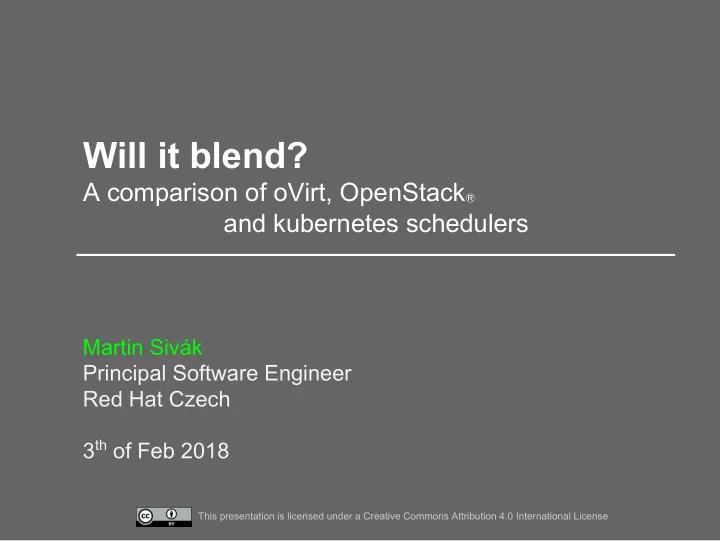

Will it blend? A comparison of oVirt, OpenStack Ⓡ and kubernetes schedulers Martin Sivák Principal Software Engineer Red Hat Czech 3 th of Feb 2018 This presentation is licensed under a Creative Commons Attribution 4.0 International License
Agenda Anatomy of a scheduler - Goals - Design considerations - The three schedulers Architecture similarities and differences - Resource tracking - Scheduling algorithm - Balancing and preemption Highlights and ideas to share 2
Goals of a scheduler Find a place with enough resources to start the given VM [1] ... … and make sure it keeps running … and make sure it handles the load … and keep the power consumption low … and ... [1] or container 3
Design considerations - Size of cluster (~ hundreds of nodes) - Deterministic algorithms - Migrations and balancing - Homogeneous cluster vs. heterogeneous cluster - Pet vs. cattle 4
Scheduler as a function CFG NODE VM A RESOURCES 5
The schedulers 6
Number comparison oVirt OpenStack kubernetes ~ Max nodes 200 ~300 5000 Language Java Python Go Load type pet VMs cattle VMs containers Resource pending + placement pod spec in tracking stats service etcd Active 1 1 or more 1 or more schedulers 7
Resource tracking 8
Resource tracking oVirt - pending resources are tracked, free resources come from reports SIMPLIFIED! management node 9
Resource tracking kubernetes - allocated resources are part of Pod spec, free = total - ∑spec API SIMPLIFIED! management node 10
Resource tracking OpenStack - a placement service handles tracking and atomic resource reservation placement SIMPLIFIED! management node 11
The Algorithm 12
Algorithm - not rocket science yes / no Remove all nodes that do not Filter satisfy hard constraints y = f(x) Map Compute score, typically based on node load and free resources Reduce Select the best node x | max(y) 13
x | max(y) yes / no y = f(x) Filtering Filter out incompatible nodes Typical filters: - CPU compatibility - Free RAM - Network presence - Storage connectivity Highlights: - Affinity - Load isolation and trust - Labels 14
x | max(y) yes / no y = f(x) Scoring Map a metric to a score like CPU load 10% to 10. Different metrics require different representation: - CPU cores, running VM count - absolute number - Free memory vs used memory - absolute or percents? - CPU load vs “free” CPU - percents, something based on frequency? SMP? - Label presence - boolean 15
x | max(y) yes / no y = f(x) Selecting the destination Which node is the best? … it depends on the goal - Maximizing performance, saving power or upgrade process? Multiple metrics need multipliers for importance kind: "Policy" nova.conf: version: "v1" weight_setting = predicates: "metric1=ratio1 ,metric2=ratio2 " ... priorities: ... - name: "RackSpread" weight: 1 So which node is the best then? - How do you sum 10%, 3.5GiB and 16 together? - Normalization! 16
Score normalization Project Algorithm To Note oVirt rank - compresses differences OpenStack scale / maximum 0 - 1 depends on filter results over all hosts kubernetes scale / single 0 - 10 incorrect on host heterogeneous clusters 17
Balancing and preemption 18
Balancing and Preemption Methods - offline migration (kill & re-start) - preemption (kill & start other) - live migration (move) “Situations” emerging at runtime - overload - rule violations (eg. new affinity defined) Selecting the best move - select the object and select the move - remember the deterministic assumption - HARD! 19
Balancing - oVirt Load balancing - equally balanced policy 20
Balancing - oVirt Load balancing - power saving policy OFF 21
Preemption - kubernetes Can we kill low priority load when needed? - Guaranteed load scheduling (DNS, network controller) - Eviction policy (Help! I am overloaded) - Disruption budget (Feel free to use one of mine) Preemption in use elsewhere: - AWS spot instances - money based priority 22
Highlights and good ideas 23
Interesting highlights Scheduling: ● oVirt optimizer (probabilistic scheduling service) ● Chance scheduler (random selection) ● Arbitrary filtering rules in spec (booleans, operators) Host devices: ● resource hierarchy and host device aliases Resource tracking ● declarative and reactive - scheduler fills in data to Pod spec 24
Good ideas ● labels ● normalization methods ● atomic resource tracking and reservation ● multiple schedulers and split-brain protection ● balancing and preemption 25
Summary All three schedulers are very similar in concept Differences are small and based on the needs of the typical workload There are ideas worth sharing! 26
THANK YOU ! Martin Sivák msivak@redhat.com with thanks to Red Hat’s OpenStack team 27
Recommend
More recommend